Over the past decade, biodegradable polyesters have played a key role in the field of biomedical engineering. While several of these polymers have been extensively studied and applied in various medical applications, there remains a great need for the development of biodegradable polymers that can be tailored towards specific applications. This study aims to investigate the polymer network architecture of thiol–ene photo-crosslinked poly-ε-caprolactone (PCL) as a tool to fine-tune a range of physical characteristics, including mechanical, thermal and photokinetic properties as well as hydrolytic degradation profiles. Additionally, the study explores the potential of thiol–ene photo-crosslinkable PCL (E-PCL) precursors to be exploited in digital light processing (DLP). The network topology was modified by adjusting the functionality of E-PCL precursors, as well as the functionality of thiolated crosslinkers. The results show that by altering the network architecture, it is possible to fine-tune the physico-chemical properties of the obtained networks. Successful application in DLP has been illustrated as well, exploiting telechelic, tri- and tetra-functional E-PCL precursors combined with a thiolated crosslinker. In conclusion, the reported strategy holds great potential to serve various biomedical applications such as medical devices, drug delivery or tissue engineering.
